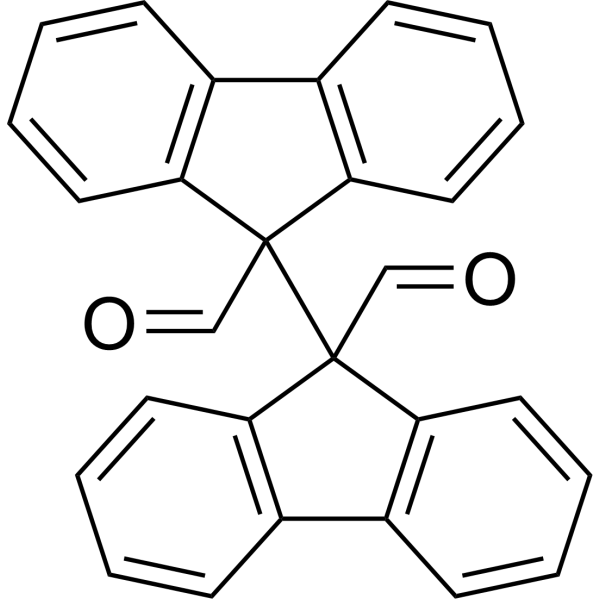Physicochemical Properties
| Molecular Formula | C28H18O2 |
| Molecular Weight | 386.44 |
| Exact Mass | 386.131 |
| CAS # | 1176-09-6 |
| PubChem CID | 355994 |
| Appearance | White to off-white solid powder |
| Melting Point | 219 °C |
| LogP | 5.317 |
| Hydrogen Bond Donor Count | 0 |
| Hydrogen Bond Acceptor Count | 2 |
| Rotatable Bond Count | 3 |
| Heavy Atom Count | 30 |
| Complexity | 580 |
| Defined Atom Stereocenter Count | 0 |
| InChi Key | GLANOOJJBKXTMI-UHFFFAOYSA-N |
| InChi Code | InChI=1S/C28H18O2/c29-17-27(23-13-5-1-9-19(23)20-10-2-6-14-24(20)27)28(18-30)25-15-7-3-11-21(25)22-12-4-8-16-26(22)28/h1-18H |
| Chemical Name | 9-(9-formylfluoren-9-yl)fluorene-9-carbaldehyde |
| HS Tariff Code | 2934.99.9001 |
| Storage |
Powder-20°C 3 years 4°C 2 years In solvent -80°C 6 months -20°C 1 month |
| Shipping Condition | Room temperature (This product is stable at ambient temperature for a few days during ordinary shipping and time spent in Customs) |
Biological Activity
| Targets | Caspase 3 |
| ln Vitro | Gastric epithelial cells' apoptotic resistance brought on by H. Raptinal is the cause of pylori infection [1]. Pro-caspase-3 can be cleaved into the active form in human gastric cancer cell lines AGS, MKN28, and MKN45 when treated with 10 μM Raptinal for two hours [1]. In a matter of minutes, raptinal triggers apoptosis in several cell lines that is dependent on the caspase intrinsic route. Numerous cancer and non-cancer cell lines can be killed by raptinal, and its 24-hour IC50 value ranges from 0.7 to 3.4 μM, suggesting that it is effective against a wide range of cell lines [2]. |
| ln Vivo | In a variety of cell lines and in vivo settings, raptinal induces caspase-dependent apoptosis exceptionally quickly [1]. In vivo anticancer efficacy is exhibited by raptinal (20 mg/kg; intraperitoneally given; once daily for 3 days in the B16-F10 model and 4 days in the 4T1 animal) [2]. A single injection of Raptinal at various doses was administered to C57BL/6 mice. Raptinal's peak plasma concentration and elimination half-life were 54.4±0.9 μg/mL and 92.1±5.8 minutes, respectively, when it was given intravenously at a dose of 37.5 mg/kg. When evaluated seven days after treatment, single intravenous doses of Raptinal were well tolerated over a broad dose range (15–60 mg/kg) and did not result in hematological damage [2]. |
| Cell Assay |
Cell Viability Assay[2] Cell Types: Human Lymphoma U-937, SKW 6.4, or Jurkat cell lines Tested Concentrations: 0.7-3.4 μM Incubation Duration: 24 hrs (hours) Experimental Results: The IC50 values of Raptinal against U-937, SKW 6.4, or Jurkat cell lines were 1.1±0.1, 0.7±0.3, 2.7±0.9 μM, respectively. Western Blot Analysis[1] Cell Types: Human gastric cancer cell lines AGS, MKN28, MKN45 Tested Concentrations: 10 μM Incubation Duration: 2 hrs (hours) Experimental Results: Induced apoptosis by activating caspase-3 within 30 min at a concentration of 10 μM. Treatment with 10 μM of Raptinal for 2 h induced the cleavage of pro -caspase-3 into it's active form in all three cell lines. |
| Animal Protocol |
Animal/Disease Models: C57BL/6 and BALB/c female mice (6-8 weeks old) bearing the B16-F10 model or 4T1 models[2] Doses: 20 mg/kg Route of Administration: Administered intraperitoneally (ip); one time/day for 3 days for B16-F10 and 4 days for 4T1 models Experimental Results: Retard tumor volume and tumor mass by 60% relative to controls in the B16-F10 model. Similar efficacy was observed for the 4T1 murine breast cancer tumor model with 50% growth inhibition after treatment. |
| References |
[1]. H. pylori infection confers resistance to apoptosis via Brd4-dependent BIRC3 eRNA synthesis. Cell Death Dis. 2020 Aug 21;11(8):667. [2]. A Small Molecule that Induces Intrinsic Pathway Apoptosis with Unparalleled Speed. Cell Rep. 2015 Dec 1;13(9):2027-36. |
Solubility Data
| Solubility (In Vitro) | DMSO : 20 mg/mL (51.75 mM) |
| Solubility (In Vivo) |
Solubility in Formulation 1: ≥ 2.5 mg/mL (6.47 mM) (saturation unknown) in 10% DMSO + 40% PEG300 + 5% Tween80 + 45% Saline (add these co-solvents sequentially from left to right, and one by one), clear solution. For example, if 1 mL of working solution is to be prepared, you can add 100 μL of 25.0 mg/mL clear DMSO stock solution to 400 μL PEG300 and mix evenly; then add 50 μL Tween-80 to the above solution and mix evenly; then add 450 μL normal saline to adjust the volume to 1 mL. Preparation of saline: Dissolve 0.9 g of sodium chloride in 100 mL ddH₂ O to obtain a clear solution. Solubility in Formulation 2: ≥ 2.5 mg/mL (6.47 mM) (saturation unknown) in 10% DMSO + 90% Corn Oil (add these co-solvents sequentially from left to right, and one by one), clear solution. For example, if 1 mL of working solution is to be prepared, you can add 100 μL of 25.0 mg/mL clear DMSO stock solution to 900 μL of corn oil and mix evenly. (Please use freshly prepared in vivo formulations for optimal results.) |
| Preparing Stock Solutions | 1 mg | 5 mg | 10 mg | |
| 1 mM | 2.5877 mL | 12.9386 mL | 25.8772 mL | |
| 5 mM | 0.5175 mL | 2.5877 mL | 5.1754 mL | |
| 10 mM | 0.2588 mL | 1.2939 mL | 2.5877 mL |
